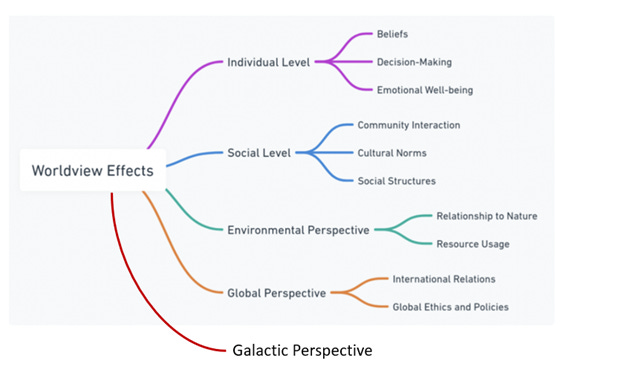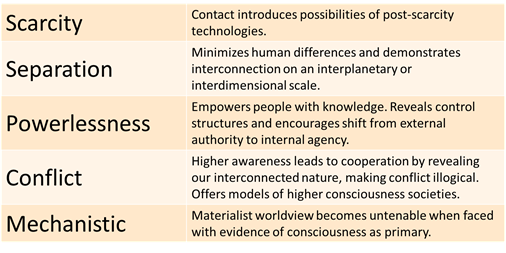Worldview Revolution: How Contact Challenges Fear Frameworks
Contact as a catalyst for a post-scarcity, post-control world

The following article is based on my recent presentation called “Beyond Materialism” at Portal to Ascension’s The Real Disclosure conference on March 11, 2025. Link to the replay is posted at the bottom.
Contact with non-human intelligence (NHI) will likely serve as a powerful catalyst for consciousness evolution by directly challenging the fear-based worldviews that have shaped modern society and suppressed human potential. This transformative process extends far beyond disclosure—it represents an opportunity for fundamental worldview reconstruction that could liberate humanity from limiting and self-loathing belief systems and enable a higher consciousness civilization based on expanded awareness, interconnection, and conscious co-creation.
This is cause for great optimism: A post-disclosure world sets the stage for a post-control world of unconstrained human evolution.
Why worldviews matter
As Jack Mezirow notes in his book, Learning as Transformation, “A defining condition of being human is our need to understand and make meaning of our experience, to integrate it with what we know to feel safe and avoid the threat of chaos.”
That meaning making becomes our worldview, which becomes the driver for how we interpret, make sense of, and engage with the world. Our worldview acts as an interpretative lens, providing the frame of reference or set of tacit assumptions and expectations that form our impressions.
Worldviews matter because they influence behavior at the individual level and across relationships, from family and friends to the global and natural world. Consistent with findings in neuroscience, the brain creates its experience of reality in a self-fulfilling prophecy.
Essentially, a worldview gives rise to corresponding beliefs or conclusions. Our brain looks to the world around us to gather evidence to prove the conclusion is correct. With our conclusion appearing valid, we behave as if it were true. This sets the stage for how others will behave in response to us, which offers more evidence of our original conclusion. This is how patterns form, personalities take hold, and individual realities are constructed.
Worldviews will also inform how we view contact and engage with other civilizations.
One possibility is that we may project onto them how we see ourselves. For example, a person who views humanity as greedy, colonizing, and exploitative may assume other civilizations have similar motivations and our fate may follow similar storylines of when higher technology societies encounter lower ones.
We may also respond to them based on how we perceive the safety and security of our world. For example, research shows that those believing the world is a dangerous place overestimate threats, believing them to be far more likely and life-threatening than real-world data supports. We have seen the ambiguity around disclosure and contact exploited by government and military mouthpieces to amplify a fear-based UFO threat narrative that will likely be leveraged in ways yet to be fully seen.
What sort of world is this?
As put forth by UPenn researcher, Jeremy Clifton, humans seek to understand their surroundings and what those surroundings and circumstances call for. He posits that a driver behind human psychology is the answer to the primal question of “what sort of world is this?”
In short, is the world good or bad?
A “world is good” worldview sees reality as beautiful, fascinating, safe, abundant, alive with intention, and improving along an evolutionary journey. This higher consciousness view positions individuals not as victims of an uncaring and uncontrollable world but as creators of and within it. It is compatible with what we are learning about consciousness and quantum physics and how reality operates as a function of frequency.
The “world is bad” perspective is essentially the opposite, viewing the world as dangerous, dull, meaningless, mechanistic, and getting worse. It is typically accompanied by a bleak view of humanity, where we are perpetually teetering on the brink of violent chaos and self-destruction.
Which general worldview is adopted is shaped by individual and collective forces, including families, social institutions, religion and myth, media, and other intervening factors. Interestingly, Clifton’s research suggests worldviews are formed independent of personal or global circumstances, like income, gender, race, and education, such that hardship does not necessarily breed negative worldviews, nor does relative ease and affluence promote positivity.
That said, early childhood experience matters. Tragically, generations of children are being taught that humans are a plague on the planet, sowing the seeds of guilt and shame simply for being alive. For one example, we can look to the fallacious burden placed on asymptomatic (i.e. healthy) children during COVID, where they were told they could kill their grandparents just by being in the same room. For children who are still forming their identities and outlook on life, this anti-human view carries a tremendous psychological toll, leading to despair, self-loathing, and a diminished sense of purpose and agency.
The psychological inducement toward negative primal worldviews isn’t new.
We have been systematically conditioned into negative worldviews through myriad institutional forces, largely operating unseen and unmitigated in our collective psyche.
The excellent documentary, Recorder: The Marion Stokes Project, highlights the deliberate way that TV news sought to mold public consciousness. Stokes recorded television news 24 hours a day from 1979 until 2012, revealing:
Stories of conflict and danger were consistently prioritized over stories of cooperation and progress
Individual acts were emphasized over collective movements
Official institutional voices were privileged over grassroots perspectives
Complex issues were reduced to simplistic us-vs-them narratives
Solutions that challenged existing power structures were marginalized
And it is not just the news. These negative beliefs are reinforced practically everywhere, creating a multi-layered framework of fear.
Frameworks of fear
The result of this programming is a belief that the world is a dangerous place that we must be protected from, largely because of five core fears:
Scarcity: There isn’t enough to go around—not enough resources, opportunities, or love. Competition over cooperation.
Separation: We are fundamentally separate from each other and nature. Isolation over interconnection.
Powerlessness: Rely on authorities and institutions rather than our own agency and collective power. Submission over action.
Conflict: Conflict, violence and competition are simply “human nature” rather than learned behaviors shaped by systems. Promotes fear of chaos. Expectations of discord over peace.
Mechanistic: The universe is essentially dead matter operating mechanically rather than a living, conscious system. Denies the inherent intelligence and aliveness of nature and cosmos.
These fear frameworks serve power by keeping people afraid, inclined toward conformity, and thus easier to control. They prop up the “world is bad” worldview and make us more susceptible to authority. As noted by Clifton:
“Hobbes (1651), for example, encouraged submission to authority to ward off societal descent into a state of nature where life is nasty, brutish, and short—ostensibly, dangerous and degenerative world beliefs (two primals) motivated his authoritarianism.”
While not completely unfounded, clearly the appeal to people’s sense of safety and security has been calculated and exploited to guide them into the cage of state control, disguised as protection. Even my research showed that people both distrust the government and look to it for answers, creating a bizarre paradox that highlights people’s psychological dependence on authority.
The good news is that once we can articulate these fear frameworks, we can begin to question and transcend them, seeking out and encouraging views that challenge the norms of the dominant culture.
The irony is that these frameworks don’t actually match human experience or scientific evidence. Research shows that humans are innately cooperative, that we’re hardwired for empathy, that grassroots movements have power, that peace is possible, and that consciousness is fundamental to the universe.
How contact challenges fear frameworks
Contact with NHI can challenge the fear frameworks in profound ways. At a high level, the confirmation that we are not alone proves that things are not as they seem. When we start pulling at that thread, we realize that the foundational assumptions underlying the prevailing view of reality are incomplete at best and completely and deliberately false at worst.
While it matters how contact plays out, like who we meet first, what their agenda is, how much knowledge and technology is transferred, and who is managing the interaction on the human side, we can explore some potentials for how our worldviews might change.
For example, imagine a world where energy constraints no longer limit human potential, where ecological systems can heal, and where we can truly ask ourselves what kind of civilization we wish to become when the false constraints of scarcity no longer dictate our choices and dim our imagination.
Such transformation would cascade through every aspect of human civilization. The petrodollar system would become obsolete, dramatically shifting power dynamics as energy access no longer determines geopolitical leverage. Extraction industries would phase out, allowing ecological restoration, while unlimited energy would enable widespread water desalinization and purification, addressing global scarcity. The constraint on material production would vanish, revolutionizing manufacturing through technologies like localized 3D printing. Human settlement patterns would transform as transportation barriers fall and previously uninhabitable regions become viable. Socially, energy-intensive automation would redefine work itself, allowing communities to become simultaneously more autonomous and globally connected.
Perhaps most profoundly, this abundance would create a psychological shift away from scarcity thinking, fundamentally transforming our relationships with each other and our planet as we recognize that it is possible to meet everyone’s basic needs.
As contact challenges fear frameworks, it simultaneously undermines the justification for authoritarian control. When scarcity is revealed as artificial and separation as illusory, the need for external authorities to “protect” us and manage resources diminishes, taking conflict and war down with it.
Instead, as will be explored in an upcoming article, a post-control civilization would likely organize around principles of personal sovereignty and collective self-governance, where communities make decisions based on expanded awareness of interconnection rather than fear-based compliance or scarcity competition. This doesn’t mean the absence of any oversight, but rather governance that facilitates human potential rather than constrains it for the benefit of a few.
The process of transformative learning
So how do people actually change their minds? Mezirow says that “Transformation theory’s focus is on how we learn to negotiate and act on our own purposes, values, feelings, and meanings rather than those we have uncritically assimilated from others to gain greater control over our lives as socially responsible, clear-thinking decision makers.”
Worldview evolution is a process of moving from the socialized to the sovereign mind.
As many awakened souls eventually realize, you can’t wake someone else up. You can’t just tell people about a new way of seeing and being—they need to discover it through their own inquiry and experience and integrate it into their own sense of meaning, which is then lived.
This process is often initiated by what Mezirow calls a “disorienting dilemma” or cognitive dissonance—an experience that doesn’t fit into one’s existing worldview, where one’s established beliefs cannot adequately explain the experience.
We see this transformative learning process in action through various paradigm shifts throughout human history. Consider how the Copernican revolution transformed humanity's understanding of our place in the cosmos—moving from Earth as the center of the universe to one planet among many. This disorienting dilemma initially met fierce resistance but eventually catalyzed a complete worldview reconstruction.
On an individual level, many experiencers and contactees report similar transformative journeys. Contact with NHI represents a profound disorienting dilemma and potentially an ontological shock. Seeing a craft do things that our science says shouldn’t be possible or encountering a being can provide the necessary break from previously held beliefs and an introduction to an expanded consciousness view.
However, meaningful change typically requires more than a single catalytic event. As stated in Learning as Transformation, “Although a single event may catalyze a shift, closer examination reveals that the change or shift was long in coming and its possibility prepared for in myriad ways, generally across years. We found no instance of transformation as the result of an isolated, epochal event.”
For these reasons, disclosure is just an initial step, not the final destination.
Disclosure as a starting point
Government disclosure creates awareness but not integration. Full integration of the realization that we are not alone will likely follow a progression, though people may enter the process at different points or proceed through it at different paces. Some may stall along this process because they compartmentalize or dismiss information that threatens their existing worldview. Others may accept the information intellectually while emotionally resisting its implications. But even this can be progress as the breaks caused by “disorienting dilemmas” are not typically fully mended, creating an ongoing opportunity for further discovery.
The transformation process is generally as follows:
Theoretical Acceptance: Intellectual acknowledgment of possibility
Evidential Acceptance: Recognition of compelling evidence
Experiential Acceptance: Direct personal or collective encounter
Cognitive Integration: Reconciling new reality with existing frameworks
Emotional Processing: Working through fear, wonder, disorientation
Worldview Reconstruction: Building new meaning structures
Behavioral Adaptation: Living differently based on new understanding
Identity Transformation: Fundamental shift in self-concept and purpose
This is an active process of becoming aware of the implicit and explicit values, assumptions, and beliefs that construct our worldview and being willing to challenge them. This might involve asking oneself, “Why do I think what I think?” It requires the mental and emotional flexibility to consider and accept new information that contrasts with prior views. Part of the cognitive integration could include discourse with others that tests assumptions across a wider range of personal experiences. Finally, as noted above, the new insights must form the basis of new choices, such that one’s actions fully align with the new worldview.
Rather than just hoping profound experiences will change people’s worldviews, we can create containers that support the full transformation process. This might look like support systems where people can safely explore their challenging experiences. Support groups could also be a place to examine assumptions about reality and process change through shared experience and dialogue, particularly with people on the other side of the transformation process. Transformational coaches like me can offer personalized support to people struggling to make sense of this new reality.
Other capacity building activities could include community education that offers a non-judgmental space to explore and normalize discussion of NHI issues. This could not only provide theoretical and evidential acceptance but potentially experiential acceptance through group sightings or other paranormal experiences. Together, these activities could lessen fear by gradually acclimating people to NHI existence and the realm beyond our consensus reality in a safe group setting.
Conscious contact
Disclosure can be a powerful disorienting dilemma that catalyzes a shift from negative to positive worldviews. It represents an individual and collective evolution of consciousness that supports higher order thinking and collective caretaking. How and when contact unfolds will largely depend on that evolution, which is exponential and inevitable.
Disclosure is an invitation to transformation. The choice is ours: Will we remain in fear frameworks or step into conscious co-creation?
What’s at stake is not just what we know, but who we become.
We all have a role to play. What will be your contribution?
Carolyn Brouillard is a passionate explorer of potential and possibility who loves to exchange ideas through writing and speaking. As a transformational coach, she helps change-seekers create a life they love through transforming their thinking and claiming their power. She is also Managing Partner of ExoFuturesConsulting, which works with forward-thinking organizations ready to explore the profound implications of contact with NHI.
Citations:
Clifton, J. D. W. (2024). Psychologists return to the first question of Western philosophy. American Psychologist. Advance online publication. https://dx.doi.org/10.1037/amp0001351
Mezirow, J. (2000). Learning as transformation: critical perspectives on a theory in progress. https://www.amazon.com/Learning-Transformation-Critical-Perspectives-Progress/dp/0787948454







More excellent writing!
"Instead, as will be explored in an upcoming article, a post-control civilization would likely organize around principles of personal sovereignty and collective self-governance, where communities make decisions based on expanded awareness of interconnection rather than fear-based compliance or scarcity competition."
This scenario is illustrated in "Summerhill" by A.S. Neill (1960)
". . . I mention the case of a boy who was always riding other children's bicycles. Brought up before a General School Meeting, he was charged with 'constantly breaking the private property rule by using other kids' bikes.' Verdict: 'Guilty!' Punishment: 'The community is asked to subscribe to buy him a bicycle.' The Community subscribed."
It seems that children from the last century already possessed the wisdom for which we look to NHI. Things don't need to be so difficult.
Insightful framing of primal world beliefs, worldviews and transformative experiences, Carolyn. Your Worldview Effects slide adds an expansion from planetary to galactic perspectives.
I recently read ‘A Logic for the Future: International Relations in the Age of Turbulence’. While it highlighted many elements towards co-creating preferred futures, it was missing a galactic perspective. It also appeared to be grounded within a physicalist worldview. As you say, transformation may be a longer process…
https://tas-education.org/exostudies/the-logics-of-education-futures/